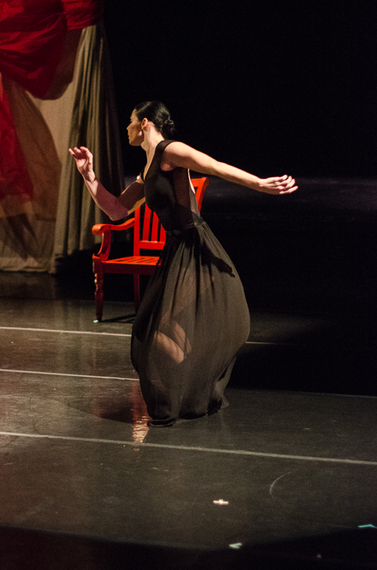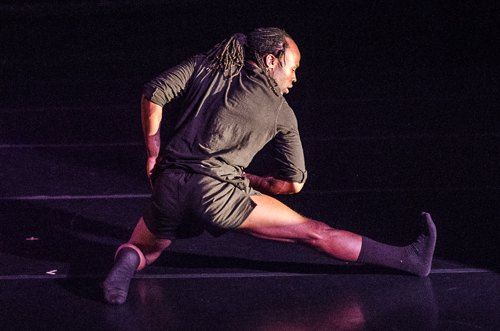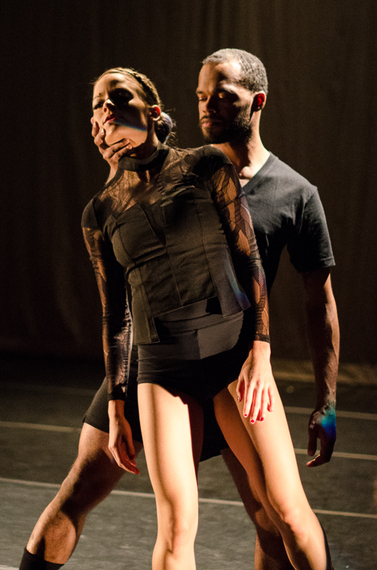Anyone who knows Lizzie Mackenzie's choreography is probably surprised that she's not better known as a choreographer. She's widely known as a truly exceptional dancer, from her performances with Giordano Dance Chicago and then with River North Dance Chicago, as well as her many guest appearances in high profile special events. She's also well known, especially in the world of preprofessional dance, as the founder and artistic director of Extensions Dance Company, one of the most successful and respected preprofessional dance companies in the country. When she does choreograph, the results are often spectacularly rich; she combines an ability to create beautiful and engaging movement designs with an unusually effective understanding of concert dance architecture.

Chantelle Mrowka and Mary Tarpley in Lizzie MacKenzie's
... and sometimes we were lost, but always we became found
Photo by Johnny Nevin
That's why the news that Lizzie MacKenzie was creating a full evening of original work would have been promising no matter what, but to hear that it was going to be for Chicago Dance Crash made the whole idea even more exciting, and much more intriguing. The work is titled ...and sometimes we were lost, but always we became found; and it's at the Ruth Page Center for the Arts in Chicago on December 13th and 14th.

Lyndsey Rhoads in Lizzie MacKenzie's
... and sometimes we were lost, but always we became found
Photo by Johnny Nevin
MacKenzie is thoughtful in everything she does, but especially in everything that has anything to do with human connection; it's one of the reasons why she's so successful as a teacher. That same thoughtfulness, that same willingness to consider new ideas and actively engage them until she can work them into all of the other things she does, also gives her an exceptional ability to learn, and to embrace new possibilities. Around the time that Chicago Dance Crash first approached her about working with the company, she had recently discovered and was hugely impressed by a lecture by a University of Houston professor named Brené Brown.
Brown's lecture is called "The Power of Vulnerability," and it's quite a phenomenon, besides being an important and thought-provoking presentation. It's part of the TED Talks series, and twelve million people have watched the twenty minute video at the TED site, besides another million or so at YouTube. "Where I started was with connection," Brown says in her talk, "because by the time you're a social worker for 10 years, what you realize is that connection is why we're here. It's what gives purpose and meaning to our lives." She goes on to examine the reasons why, despite it's importance, connection to others can be so problematic, and she develops the insightful idea that the people who are best able to share connections with others are those who are least afraid of their own vulnerability.

Daniel Gibson in Lizzie MacKenzie's
... and sometimes we were lost, but always we became found
Photo by Johnny Nevin
"There were so many ideas in her talk that really resonated with me that I felt that it was the most potent influence in my life at that moment," MacKenzie says, "so it made sense for me to utilize that as my story line for this conceptual work." Which is where Chicago Dance Crash comes in.
Very few dance companies know as much about connecting with an audience as Dance Crash does, and the connections between the members of the company are vividly evident whenever you see them perform. On the other hand, "vulnerability" is one of the last words you would expect to find in the thesaurus if you looked up "Chicago Dance Crash." Besides their unique ability to seamlessly combine dance styles from hip hop to ballet, throwing caution to the wind is a hallmark of their unique programming. They're probably best known for their immensely popular concept works like last summer's The Cottonmouth Club or 2012's Gotham City, where, completely unafraid of addressing popular culture in richly artistic ways, they consistently manage to redefine convention just by defying it so well.

Jessica Deahr and David Ingram in Lizzie MacKenzie's
... and sometimes we were lost, but always we became found
Photo by Johnny Nevin
Something that's less widely known about them is that each year they close their season by bringing in an important guest choreographer or choreographers and, vulnerable or not, throw themselves into the challenge of embracing whatever kind of movement and performance that choreographer brings to them. Despite the fact that, each in their own ways, they and MacKenzie are so widely admired, it could easily be seen as an improbable connection; which brings us right back to Brené Brown, and the power of vulnerability.
MacKenzie opens the work with Dance Crash's Kaitlin Webster sitting in a chair reading a book. "It's like being inspired to make a change in your life -- the book is like a catalyst for a change in perspective," MacKenzie says, describing the way that her reflection on Brown's work takes form in ...and sometimes we were lost, but always we became found. "Then this red chair is more like the things that hold you back, kind of your comfort zone, yet you know that it's not really where you want to be. It's very much where you are, though, and very much where you're comfortable because it's what you've always known." With Dance Crash's impressive and eclectic movement abilities as her palette, MacKenzie goes on to paint a series of moving pictures of the process by which people encounter both vulnerability and courage as they face questions of their own sense of self-worth and, inevitably, of their connection to others.

Kaitlin Webster in Lizzie MacKenzie's
... and sometimes we were lost, but always we became found
Photo by Johnny Nevin
It was always going to be fascinating to see what came of the collaboration between such talented but different artists, but precisely because of those different artistic cultures, ... and sometimes we were lost, but always we became found is especially rich and compelling. Because the process of making the work is so emblematic of its subject, it offers a unique chance to watch how the uncertainty, and ultimately the vulnerability, of any creative process can in itself be the source of a completely new, and previously unimagined, artistic connection.
This story originally appeared at aotpr.com
